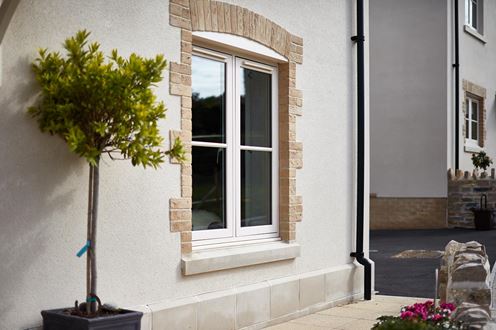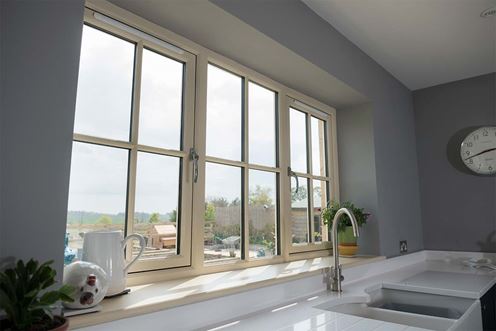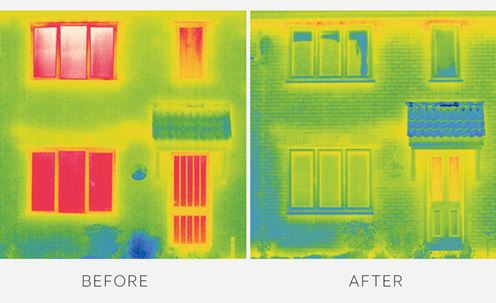Learning about the energy efficiency of windows helps you to make informed choices on ways to help lower your heating bills and carbon footprint. Energy efficiency depends on the window type, how well it retains heat, reduces draughts and how much of the sun's energy travels through it. This guide explains the effect that glazing, material and style have on the energy efficiency of different window types.
The Window Energy Rating (WER) system measures how well the glass and frames of a window prevent heat loss, reduce draughts and absorb solar energy. It is the industry standard for rating energy efficiency in windows. Developed by the British Fenestration Rating Council (BFRC), the ratings go from A++ to E, with A++ being the highest.

Window glazing energy efficiency differs depending on which type of glazing you choose. For example, our double glazing is up to A+ rated in uPVC, and triple glazing is up to A++ in the uPVC flush style. Secondary glazing has no WER rating because its energy efficiency depends on the existing window it sits behind.
Double glazing has two panes of glass, a thermal spacer bar – or spacers – and a layer of argon gas to prevent draughts, lock in heat and harvest energy from the sun. Triple glazing has three glass panes, two spacer bars and two layers of gas, giving it protection from draughts, improved ability to absorb solar energy - solar gain - and better heat retention. The right glazing type for your home depends on the surroundings and elevation.
The space between glass in double and triple-glazing is integral to the energy performance of all types of window. Spacer bars separate the glass panes and the gap between them is filled with inert gas. The gas is a great insulator and its poor heat conductivity lowers the heat escaping your home. Spacer bars are metal strips that insulate the edges of the glass, further reducing heat loss. The combination of the pane gaps and spacers contribute to the energy efficiency of your windows.
Double glazed windows reduce heat escaping your home and cold air from entering. There’s a double layer of Low-E glass which reflects heat back into your home. The internal pane of glass is about the same temperature as your home, so if your windows are cold, they may have blown or your home is too cold. The airtight seals of the unit keeps draughts from getting between the panes or the casement and frame. By far the most popular window option, energy-efficient double-glazing is available in all our window styles and designs with ratings up to A+.
The extra layer of Low-E glass, a second thermal spacer bar and two layers of argon gas make triple glazed windows energy-efficient. It’s better than double-glazing at retaining heat, reducing draughts and absorbing warmth from the sun. But there are benefits to mixing and matching triple and double glazed windows for the best year-round energy and heat performance. Our energy-efficient triple-glazing is available with uPVC frames, A+ rated in casement, or A++ rated in flush.
Secondary glazing works by adding a second window behind an existing one, reducing draughts and heat loss. It is often more affordable than replacing windows with double or triple-glazing. If you have a listed or period property, the energy efficiency from secondary glazing helps reduce heat loss without changing its looks. This type of improvement naturally adds value to your home. Secondary glazing does not have an energy rating. This is because they can be fitted behind any kind of window, meaning their energy-saving benefits depend on the window they sit behind.

Different types of windows made from materials such as uPVC, wood or aluminium affect energy efficiency performance ratings. For example, our flush uPVC type of window is A++ rated in triple glazing, the highest rating given by the BFRC. This section will help you decide which material is best for your home and how to save the most energy.
uPVC window energy efficiency is one of the main reasons this type is our most popular choice. Double glazed uPVC windows are A-rated as standard, A+ in triple glazing, and A++ in our flush style. Only uPVC windows can be fitted with our triple glazing, making it our most energy-efficient material.
| B energy rating | A energy rating | A+ energy rating | A++ energy rating | ||
|---|---|---|---|---|---|
| uPVC Casement | ✔ | ✔ | ✔ | - | View Casement |
| uPVC Flush Casement | - | - | ✔ | ✔ | View Flush Casement |
| uPVC Sash | - | ✔ | ✔ | - | View Sash |
| uPVC Tilt and Turn | ✔ | ✔ | - | - | View Tilt and Turn |
As a natural insulator, there’s a lot to be said about energy-efficient wooden windows. Wood conducts heat less than other materials, meaning it keeps heat in and absorbs less heat from the sun. Our wooden windows are available in double glazed and are A-rated as standard in every style except traditional cord and weight sash. To make your existing wooden windows more energy-efficient, consider secondary glazing. It costs less than replacing your windows and no planning permission is needed.
| B energy rating | A energy rating | A+ energy rating | A++ energy rating | ||
|---|---|---|---|---|---|
| Wooden Casement | - | ✔ | - | - | View Casement |
| Wooden Flush Casement | - | ✔ | - | - | View Flush Casement |
| Wooden Sash | ✔ | ✔ | - | - | View Sash |
| Wooden Bay | - | ✔ | - | - | View Bay |
The energy efficiency of aluminium windows can be overlooked. Our aluminium windows have a thermal break and insulated frames to improve heat gain and reduce heat loss. A thermal break means the frame is in two parts. These two parts are bonded together by a material which conducts heat poorly. This means the frame both loses and absorbs less heat. They also have three seals, two weather seals and one to reduce draughts. As a result, our energy-efficient aluminium windows have a U-Value of 1.4 W/m²K as standard. The U-value refers to how well your window retains heat. The lower the value, the better the window is at retaining heat.
The style of a window affects its energy efficiency. Some styles are only available in certain materials, and some open differently which affects their rating. As a result some styles have higher BFRC ratings than others. Choose a style that is not only right for your home but achieves the energy saving results you��re looking for.
| Casement | Sash | Tilt & Turn | Bay | Cottage | ||||||
|---|---|---|---|---|---|---|---|---|---|---|
| uPVC | Wood | uPVC | Wood | uPVC | Wood | uPVC | Wood | uPVC | Wood | |
| A++ rated | ✔ | - | - | - | - | - | ✔ | - | - | - |
| A+ rated | ✔ | - | ✔ | - | - | - | ✔ | - | ✔ | - |
| A rated | ✔ | ✔ | ✔ | ✔ | ✔ | - | ✔ | ✔ | ✔ | ✔ |
| B rated | ✔ | - | - | ✔ | ✔ | - | ✔ | ✔ | ✔ | ✔ |
| Triple Glazing | ✔ | - | - | - | ✔ | - | ✔ | - | - | - |
Bay windows are a prime example that style doesn't mean a compromise on energy performance. They are available in every material and glazing option, including casement, flush casement and sash styles rated B-A++.
| Casement Bay | Cottage Bay | Flush Casement Bay | Sash Bay | |||||
|---|---|---|---|---|---|---|---|---|
| uPVC | Wood | uPVC | Wood | uPVC | Wood | uPVC | Wood | |
| B rated | - | - | - | - | - | - | - | ✔ |
| A rated | ✔ | ✔ | ✔ | ✔ | - | ✔ | ✔ | ✔ |
| A+ rated | ✔ | - | - | - | ✔ | - | - | - |
| A++ rated | - | - | - | - | ✔ | - | - | - |
Casement windows can be customised to be the most energy-efficient window, depending on the material. Energy-efficient casement windows are available as double glazed in aluminium, uPVC and wood, and triple glazed in uPVC. High energy efficiency ratings mean our casement windows keep your home warm and save money on your energy bills.
| Casement Windows | uPVC | Wood |
|---|---|---|
| A rated | ✔ | ✔ |
| A+ rated Triple Glazing | ✔ | - |
Popular in Georgian Britain, Energy-efficient sash windows used to be unheard of in Georgian Britain. Older wooden sash windows do not have an airtight seal, which allows draughts to enter and heat to escape.
Times have changed. Our modern energy-efficient sash windows achieve up to an A+ rating with uPVC, and up to A with wood. Both our wooden and uPVC sash windows have weather seals and cam locks that block out draughts and reduce heat loss. The high energy performance of our uPVC and Wood sash windows means that you can replace your old windows on a heritage or listed property without falling foul of planning regulations. Consider secondary glazing for a more affordable option than replacing your existing sash windows to make them more energy-efficient.
| Sash Windows | uPVC | Wood |
|---|---|---|
| B rated Double Glazing | - | ✔ |
| A rated Double Glazing | ✔ | ✔ |
In the past, old flush windows were single glazed and draughty. Today, energy-efficient flush windows are among the best for performance. Double glazed flush windows are A-rated in wood, but A+ rated in uPVC. Triple glazed uPVC flush windows achieve the highest rating of A++. Materials and glazing in flush windows are the two biggest factors on energy performance, but construction also plays a part. Internal and external weather seals reduce draughts and heat loss. The energy calculator developed by the Glass & Glazing Federation (GGF) shows that installing A++ rated triple glazing could save you as much as £207.87 a year on your energy bills*.
* Source Glass and Glazing Federation. A typical detached house has 23.7m2 of windows. Based on replacing uPVC double glazed windows with a 12-14mm sealed unit and gas central heating with A++-Rated thermally efficient windows.
| Flush Windows | uPVC | Wood |
|---|---|---|
| A+ rated Double glazed | ✔ | ✔ |
| A++ rated Triple glazed | ✔ | - |
Energy-efficient tilt and turn windows are available in uPVC and come rated B for energy efficiency with double glazing. This means they are effective at reducing draughts, limiting heat loss and making the most of the sun's warmth. Our tilt and turn windows can also be triple glazed, achieving an A rating. Mix and match between double and triple glazed tilt & turn windows to enjoy comfortable temperatures all year round.
| Tilt & Turn Windows | |
|---|---|
| B-Rated Double Glazing | ✔ |
| A-Rated Triple Glazing | ✔ |
| A+ Rated Triple Glazing | - |
Cottage windows are made with uPVC or wood, which are very energy-efficient. They have the same energy-efficient design as our casement windows. The difference is the extra glazing bars, which make each pane of glass look separate. The combination of our unique double glazing unit and insulating properties of wooden or uPVC frames means cottage windows achieve an A-rating in wood or uPVC and an A+ rating in flush uPVC.
| Cottage Windows | uPVC | Wood |
|---|---|---|
| B rated | ✔ | ✔ |
| A rated | ✔ | ✔ |
| A+ rated | ✔ | - |

Investing in new types of energy-efficient windows helps increase the thermal efficiency of your home, reduces heat loss and keeps your home warmer for longer. This means you heat your home for less, lower your energy bills and save money. Because there are so many options to choose from, you can have windows that improve the appearance of your home and the energy rating. Doing so can also add value to your property, with potential buyers attracted by both improvements.
Download the Infrared Test Report hereFor over 55 years, Anglian have led the way in installing energy-efficient windows across the UK. Our types of windows exceed industry standards for energy efficiency, with the majority rated A or higher. Choosing our energy-efficient windows for your home will mean you use less energy, lowering your heating bills and even your carbon footprint. Find out how much difference Anglian energy-efficient windows can make to your home. Get a windows quote today.


